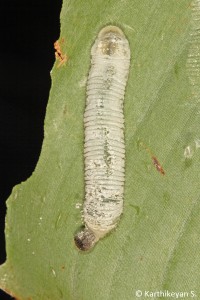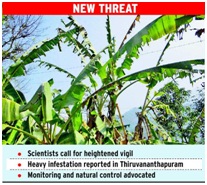Banana skipper (Erionota thrax) butterfly is from South East Asia, where the  caterpillars (larvae) cause the major damage to infested plants. This pest is also known as the banana leaf roller or palm redeye. After hatching, the caterpillars move towards the outer edge of the leaf where they feed and roll the leaf to make a shelter. Within the roll the larva secretes a protective, white, waxy covering. The feeding and rolling destroys the leaves, significantly reducing the plant’s leaf area and leading to reduced fruit production, as well as preventing the use of the leaves for traditional purposes. The adult female lays small yellow eggs in batches of 12–25 on lower leaf sides, from which the caterpillars emerge. Caterpillars roll up banana leaf sections and eat the leaves as they grow. They also exude a fine white powdery material over their body. Adult butterflies are brown with three yellow-white areas at the front of their wings. They have a wingspan of around 7cm.
caterpillars (larvae) cause the major damage to infested plants. This pest is also known as the banana leaf roller or palm redeye. After hatching, the caterpillars move towards the outer edge of the leaf where they feed and roll the leaf to make a shelter. Within the roll the larva secretes a protective, white, waxy covering. The feeding and rolling destroys the leaves, significantly reducing the plant’s leaf area and leading to reduced fruit production, as well as preventing the use of the leaves for traditional purposes. The adult female lays small yellow eggs in batches of 12–25 on lower leaf sides, from which the caterpillars emerge. Caterpillars roll up banana leaf sections and eat the leaves as they grow. They also exude a fine white powdery material over their body. Adult butterflies are brown with three yellow-white areas at the front of their wings. They have a wingspan of around 7cm.
Banana skipper butterflies have brown bodies with large heads, large red eyes and thickened, curved antennae tips. Each wing is 31-37 mm wide, with three yellow areas on the forewings. Banana skipper butterflies are called skipper butterflies due to their fast, darting flight movements. They are attracted to light.
 The skipper larvae are present in the rolled-up sections of leaves. Unroll the leaf curls and check for the presence of the caterpillars and/or their white powdery covering. Banana skipper caterpillars damage banana plants by feeding on and rolling up the leaves. The caterpillars can damage 60% of the plant leaf area. Leaf damage lowers banana yields due to delayed fruit maturity and reduced bunch size. The adult butterflies are most active in the early evening and are not commonly seen.
The skipper larvae are present in the rolled-up sections of leaves. Unroll the leaf curls and check for the presence of the caterpillars and/or their white powdery covering. Banana skipper caterpillars damage banana plants by feeding on and rolling up the leaves. The caterpillars can damage 60% of the plant leaf area. Leaf damage lowers banana yields due to delayed fruit maturity and reduced bunch size. The adult butterflies are most active in the early evening and are not commonly seen.
Banana skipper is currently widespread in South East Asia, and is also found in Papua New Guinea, Mauritius, Guam and Hawaii. They were particularly devastating to banana crops in Papua New Guinea in the 1980s. Its close  proximity to northern Australia is a concern to the Australian banana industry.
proximity to northern Australia is a concern to the Australian banana industry.
Banana skipper butterfly infests cultivated and wild bananas (Musaceae). They can spread longer distances as eggs on the leaves of infested banana propagation material or as undetected butterflies on boats, vehicles or aircraft.
Let’s take a look at the following article on the damage done by banana skipper;
Banana farmers reel under ‘butterfly’ attack
NANDAKUMAR, July 7, 2014
Scientists at the Kerala Agricultural University have called for heightened vigil against a new and devastating pest that threatens to blight banana crops in the State.
The pest, identified as the Banana Skipper or Palm Redeye (Erionota thrax), is a chocolate-brown butterfly belonging to the family Hesperidae. It is also known as Banana Leaf Roller because its larva or caterpillar cuts the leaves at the edges and makes a series of cylindrical rolls before developing into a pupa. A heavy infestation could damage the whole banana leaf, leaving only the midrib intact.
 According to Dr. Arthur Jacob, Professor and Head of the KAU’s instructional farm at Vellayani near here, the pest was reported last year from different locations in the State. He said the damage was now found to be spreading to the southern parts, especially Thiruvananthapuram, a major producer of banana. The infestation has been found to be heavy in a few banana farms at Kalliyoor, Kakkamoola and Pallichal near Vellayani.
According to Dr. Arthur Jacob, Professor and Head of the KAU’s instructional farm at Vellayani near here, the pest was reported last year from different locations in the State. He said the damage was now found to be spreading to the southern parts, especially Thiruvananthapuram, a major producer of banana. The infestation has been found to be heavy in a few banana farms at Kalliyoor, Kakkamoola and Pallichal near Vellayani.
Originally reported from Southeast Asia, the banana leaf roller pest is distributed in Northeast India, Sikkim, Nepal, the Andaman islands, Mauritius, Malaysia, China, Vietnam, Hawaii and Papua New Guinea. Measuring 4 to 6 cm in length, the white powder-coated caterpillar prefers banana leaves though it is occasionally found to infest coconut palms also.
Citing reports from other countries, Dr. Arthur said natural control was the best remedy. The introduction of natural parasites has been advocated to bring the damage under control.
An expert team of the KAU has advised farmers to be vigilant against the spread of the pest. The scientists have called for field scouting and periodic destruction of the rolled leaves by burning to kill the larvae. “Chemical control measures are seldom required, but if the manual removal of the leaf rolls is not possible, treatments timed to control the newly hatched larvae may be attempted with the backing of field studies,” Dr. Arthur said.
C Tech Corporation can offer a solution to overcome this problem. Our product Combirepel™ is an extremely low toxicity and extremely low hazard and eco-friendly rodent aversive. Combirepel™ is available in the form of solid masterbatches, liquid concentrate and in lacquer form. The product is compliant with RoHS, RoHS2, and REACH and is FIFRA exempted. This product acts through a series of highly developed intricate mechanism ensuring that rodents are kept away from the target application.
The fencing and tree guards can be coated withCombirepel™ to protect the trees, shrubs etc. from the damage caused by the grey squirrels. The product can also be incorporated into agricultural films, greenhouse films, plastic mulches used on a large scale in the agriculture as well as horticulture sector in order to avoid damages caused by these squirrels to fruits and vegetables. Also, the products can be directly incorporated in the polymer matrix during processing of pipes and tubing. Combirepel™ does not leach out, thus there is no soil pollution. Groundwater reserves are also not polluted. Also the non-target beneficial species like earthworms, bees etc are not affected.
The product is compliant with ROHS, ROHS2, ISO, REACH, APVMA, NEA, EU-BPR, and FIFRA exempted.
Contact us at technical.marketing@ctechcorporation.com if you’re facing problems with rodents and get best remedies to combat the pest menace.
Also, visit our websites:
http://www.ctechcorporation.com/
http://www.rodrepel.com/
http://www.termirepel.com/
http://www.combirepel.com/
Follow our Facebook pages at:
1] https://www.facebook.com/Combirepel-411710912249274/
2] https://www.facebook.com/Termirepel-104225413091251/
3] https://www.facebook.com/Rodrepel-120734974768048/
Follow us on our Twitter pages at:
1] https://twitter.com/rodrepel
2] https://twitter.com/termirepel
3] https://twitter.com/combirepel
